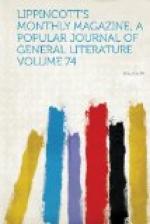Now, having briefly described Kiku’s wedding, perhaps we should stop here. Although fairly married, however, Kiku was not through the ceremonies of the night. Before her own parents left the house she was taken by the attendant ladies before her parents-in-law, and with them drank cups of wine and exchanged gifts. All the bridal presents were displayed during the evening in her dressing-room, and the whole of her trousseau was open to the inspection of all the ladies present. Feasting and dancing were the order of the hours until midnight, and then Kiku’s parents bade her farewell, and she was left a bride in a new home.
“Where did the young couple go?” “What was the route of their bridal-tour?” “Perhaps they made a late wedding-journey?” “Of course Japan has many fine watering-places to which married couples resort?” These are American questions. The fashion of making bridal-tours is not Japanese. Many a lovely spot might serve for such a purpose in everywhere beautiful Japan. The lake and mountains of Hakone; the peerless scenery, trees, waterfalls and tombs of Nikko, where sleeps the mighty Iyeyasu, the founder of the Tokugawa line; the spas of Atami,—all these are spots which if in America would be thronged with bridal-parties. Caucasians in Japan even make Fusiyama’s summit the goal of their wedded steps, but our Kiku and Taro went nowhere.
“At home” for three days is the general rule in Japan. All their friends came to see them, and presents were showered on the happy pair. The great Sho-gun, remembering his former page, sent Taro a present of a flawless ball of pure rock-crystal five inches in diameter. Prince Echizen, his feudal lord, presented him with a splendid saddle with gilt flaps and a pair of steel stirrups inlaid with




